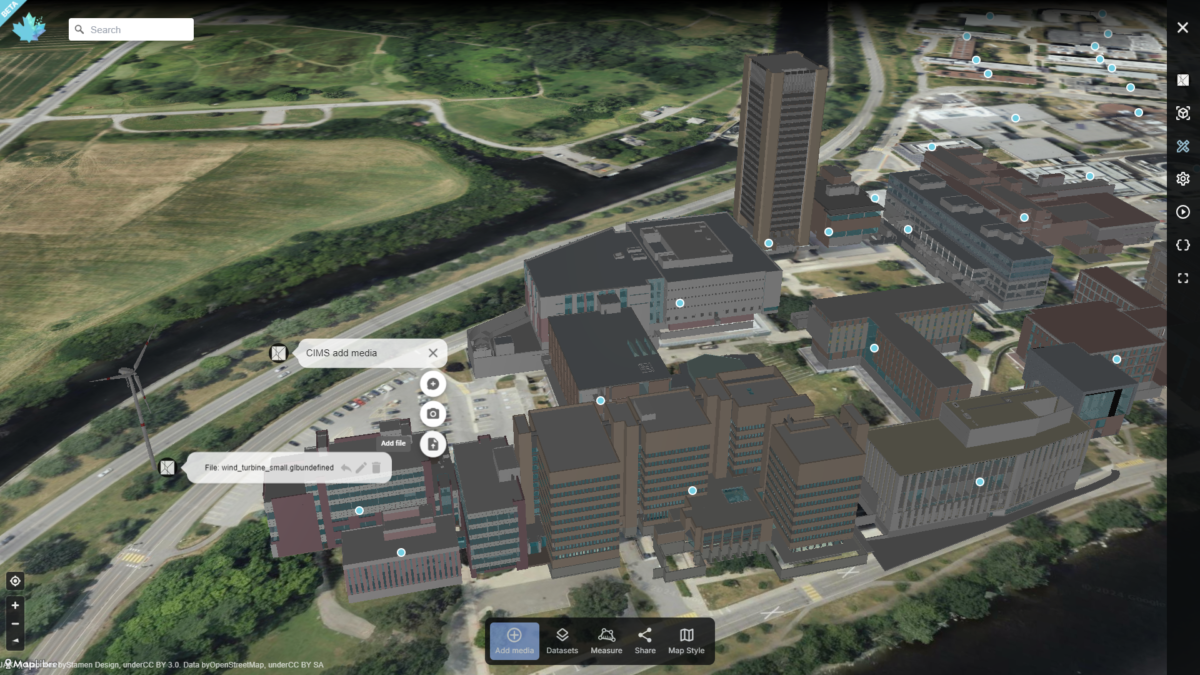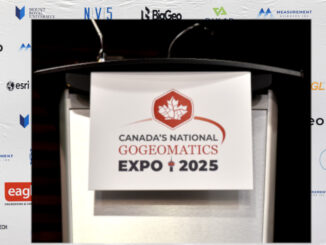
 In the rapidly evolving landscape of architecture, engineering, construction, and operations (AECO), technology and data integration are becoming increasingly vital for effective decision-making and collaboration. At the forefront of this transformation is an innovative open-source Digital Twin platform being developed by the Carleton Immersive Media Studio (CIMS), Carleton University. This platform aims to democratize access to vital data, enabling stakeholders– from government agencies to private companies and the general public – to engage with a shared repository of information. Despite the potential of such technologies, Canada has so far lagged behind many developed countries in Digital Twin adoption, making this platform even more crucial for the construction and built industry in the country.
In the rapidly evolving landscape of architecture, engineering, construction, and operations (AECO), technology and data integration are becoming increasingly vital for effective decision-making and collaboration. At the forefront of this transformation is an innovative open-source Digital Twin platform being developed by the Carleton Immersive Media Studio (CIMS), Carleton University. This platform aims to democratize access to vital data, enabling stakeholders– from government agencies to private companies and the general public – to engage with a shared repository of information. Despite the potential of such technologies, Canada has so far lagged behind many developed countries in Digital Twin adoption, making this platform even more crucial for the construction and built industry in the country.
In this interview, Nicolas Arellano, Team Lead at CIMS, shares insights into the project’s progress, the challenges of integrating diverse datasets from multiple sources, and the role of real-time data in enhancing decision-making capabilities. He also discusses the potential of this Digital Twin platform to address pressing issues, such as Canada’s housing crisis, and the importance of open standards for collaboration and interoperability within the AECO industry.
Could you tell us more about the open-source Digital Twin platform for Canada that is currently under development and its progress?
At Carleton Immersive Media Studio (CIMS), we are researching and prototyping an open-source collaboration platform. Our premise is that data should be easily accessible to all project stakeholders, regardless of their access to licensed software. To achieve this, the platform under development allows users to integrate multiscale and multidisciplinary datasets into a single model through a web browser, without the need for additional software. The platform can be accessed from any internet-enabled device. It supports the upload of Building Information Modeling (BIM), Geospatial Information Systems (GIS), and various media types, all of which can be integrated with near real-time and open datasets from sources such as the federal government (e.g., StatsCan, NRCan), provincial agencies (e.g., Open Ontario, BC Data Catalogue), infrastructure providers (e.g., Hydro), and urban centers (e.g., Open Ottawa, Données ouvertes – Ville de Montréal).
The platform is designed to be non-proprietary and flexible, evolving as new technologies emerge. We’ve identified all the technologies required to make this a viable product, though we’re still working on improving scalability and maintainability. We aim to make the entire source code and platform freely available by early 2025.
How does the platform integrate data from multiple scales, from individual assets to city-wide datasets? What challenges have you faced in achieving this level of integration?
Canada has several open data repositories at various scales, but there are three main challenges in integrating them. First, using these resources often requires some GIS training, as many datasets come in formats like CSV, JSON, GeoJSON, WMS, and WFS – formats that may be unfamiliar to the average Architecture, Engineering, Construction, and Operations (AECO) user. Second, these data portals are siloed, meaning they typically offer viewers and map visualizations for specific datasets, but it’s difficult to compare layers from different sources without specialized GIS software (like QGIS or ArcGIS). Third, each entity uses a different data management system (e.g., CKAN, ESRI, Open Data Smith, and Socrata), and there’s no standardized, well-implemented national framework for managing and publishing datasets.
To address these challenges, we’re developing a user interface that is intuitive enough for anyone to use, even without GIS knowledge. We also allow for the overlapping of layers from multiple sources, regardless of the data management system. This ensures a consistent visualization of both geospatial information and metadata.
With the platform being open source, how do you envision it being used by various stakeholders, including government agencies, private companies, and the general public?
While the framework is open, each agency is responsible for hosting and maintaining its own data. The platform doesn’t store any data; it simply links structured data. Therefore, we encourage all stakeholders to follow open standards as much as possible (e.g., ISO, bSI, and OGC standards).
As for the platform’s open-source nature, the idea is for it to be transparent, comprehensive, and community-driven. If users need a specific feature, they will be able to request, propose, or even create it. We’re working to make the code accessible and understandable so that any developer can contribute to the platform’s co-development.
Can you discuss the role of real-time data integration within a Digital Twin platform and how it enhances decision-making for users in the AECO industry?
We’re currently working on enabling near real-time interaction between users via WebSockets, which allow full-duplex communication between browsers so that users can collaborate in a shared environment. We’ve tested dynamic data, including wildfire propagation from NRCan, bus locations from the OC Transpo API, and randomly generated data to simulate sensor input. Our platform can integrate and visualize almost any type of digital media, and we’re eager to expand this capability. We hope to collaborate with others to make data integration more universal, secure, and robust.
Do you see the need for a national mandate on BIM and Digital Twin adoption in Canada?
Yes, we definitely need standards to enhance collaboration and interoperability. However, if a national mandate is introduced, it should be an OpenBIM mandate. A mandate that promotes proprietary solutions or closed file formats will not foster collaborative workflows.
ALSO READ: Interview: Does Canada’s Construction Industry Need a National BIM Mandate to Catch Up?
Could Digital Twin technology help address the housing crisis in Canada, particularly in the AECO industry?
Similar to Building Smart Canada’s approach, we believe the solution to the current housing crisis in Canada requires a combination of top-down and bottom-up strategies. All levels of government must collaborate closely with community groups, developers, and contractors. As you said, this is a crisis, and there’s no time for politics, egos, or profit motives to delay the creation of affordable housing. Success depends on a multidisciplinary, collaborative effort.
CIMS is supporting several housing initiatives across Canada. We’re exploring how these initiatives can use the Digital Twin platform to share geographically unique datasets in a national geospatial environment that also supports OpenBIM. This will allow stakeholders to visualize, compare, and contrast local, regional, provincial, and national efforts in near real-time, enabling them to ask crucial questions about what is and isn’t working, and why.
What future technologies are you most excited about, and how do you see them impacting Canada’s construction and infrastructure sectors?
Open-source GIS tools have been available for decades, with applications like QGIS, Maplibre GL JS, and BlenderGIS democratizing GIS technology and allowing professionals to be competitive without needing expensive licenses. Unfortunately, BIM has not seen the same open-source development—until recently. Tools like BonsaiBIM (formerly BlenderBIM) and That Open Engine (formerly IFC.js) are just starting to open up the conversation around fully open-source BIM software.
I’m optimistic these tools would become as robust as proprietary ones within the next few years. If that happens, I’m excited about the potential for a national OpenBIM mandate that doesn’t impose proprietary solutions or costly software licenses. The open nature of these tools also enables better BIM/GIS integration, something rarely achieved with existing proprietary software. To move the AECO industry forward, we need more open solutions, better adoption of standards, and a more digitally literate workforce.









Be the first to comment